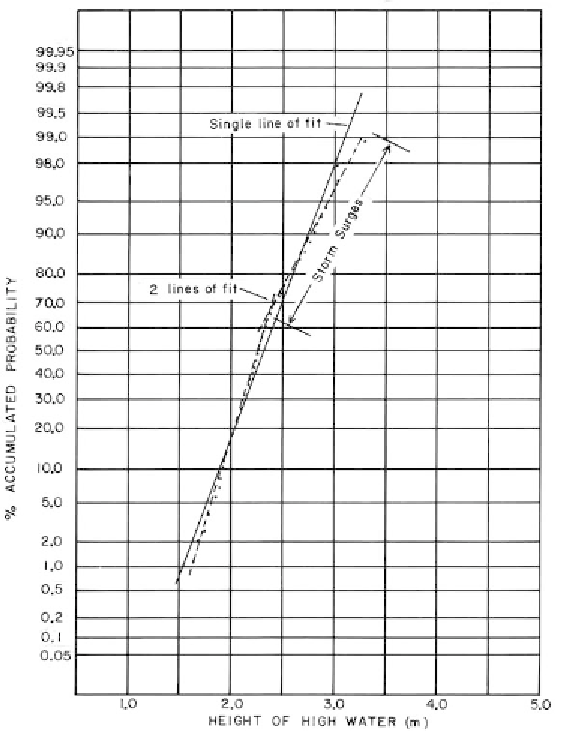Geoscience Reference
In-Depth Information
99.9
99.8
99.5
99.0
98.0
Single line of fit
95.0
90.0
80.0
70.0
60.0
50.0
40.0
30.0
20.0
2 lines of best fit
10.0
5.0
2.0
1.0
0.5
0.2
0.1
1.0
2.0
3.0
4.0
5.0
Height of high water (m)
Fig. 3.28
Probability of exceedence diagram for the same data set as depicted in Figure 3.27 (data from Wemelsfelder, 1961).
more frequent and to higher elevations than at present.
The 1:10 000 storm-surge elevation planned for today
could also be exceeded by an event smaller than 5 m if
mean sea level were to rise. Finally, neither diagram
may be the most appropriate method in engineering
design to determine the frequency of rare events. In
the case where high-magnitude events tend to cluster
over time, engineers will resort to frequency distribu-
tions that are more complex to permit the recurrence
of clustered events to be evaluated more realistically.
800 million tonnes of dust, with extremes as high as
5000 million tonnes, are entrained by winds each year.
The average annual amount of clay-sized particles
moved is about 500 million tonnes. Dust storms are
responsible for most of the terrigenous material found
in ocean basins, contributing over 75 million tonnes of
material per year to the Atlantic Ocean alone. At
distances 5000 km out into the Atlantic Ocean, fallout
from the Sahara is still deposited at a rate of
3000 tonnes km
-2
yr
-l
. Dust from the Sahara is fre-
quently deposited 7000 km away on Caribbean islands
and in the North Amazon Basin. In the latter location,
it accumulates at the rate of 13 million tonnes every
year. Saharan dust often falls over western Europe with
single storms being used as marker horizons in glaciers
in the Alps. Dust from China exceeds these statistics.
Dust from the Gobi Desert has been recorded in
Hawaii and Alaska, a distance in excess of 10 000 km.
A dust plume, which left China around 25 February
DUST STORMS
(Lockeretz, 1978; Goudie, 1983; Middleton et al., 1986;
Pearce, 1994; Tegen et al., 1996; Griffin et al., 2002)
Intro
duction
Dust storms are windstorms accompanied by sus-
pended clay and silt material, usually but not always
without precipitation. Presently, between 130 and























